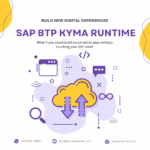In today’s dynamic global market, supply chains are more than just a series of steps; they are the lifeblood of an organization’s ability to serve its customers and stay competitive. Yet, too often, companies treat supply chain planning as a static, annual process. The reality is far different. In a world of rapid change—where disruptions are inevitable and customer demands evolve continuously—agility becomes paramount.
Ask yourself: Why should supply chain planning be agile? Because a rigid approach not only limits responsiveness but also stifles innovation. When businesses fail to adapt, they risk lost opportunities, increased costs, and ultimately, diminished trust from customers and partners. True resilience lies in the ability to anticipate change, quickly realign resources, and continuously innovate the planning process.
The How: SAP IBP as a Catalyst for Transformation
This is where SAP Integrated Business Planning (IBP) enters the picture. SAP IBP is not just another planning tool; it is a comprehensive solution designed to empower organizations with the agility and insight needed for modern supply chain management. It brings together data, analytics, and real-time collaboration, transforming planning from a reactive exercise into a strategic, forward-looking discipline.
SAP IBP integrates multiple planning processes—demand planning, supply planning, sales and operations planning, and inventory optimization—into one cohesive system. By doing so, it ensures that every part of the organization is aligned, from procurement to production, distribution to customer service. This integration is critical in today’s complex and interdependent business environment.
The What: Features and Benefits of SAP IBP
Real-Time Analytics and Forecasting
One of the core strengths of SAP IBP is its ability to provide real-time analytics. Rather than relying on historical data alone, SAP IBP leverages predictive analytics to forecast future demand and supply scenarios. This forward-looking approach means that decision-makers are not simply reacting to past trends; they are proactively shaping the future.
- Data-Driven Insights: With access to a unified data platform, businesses can make informed decisions that reflect both current realities and future possibilities.
- Predictive Forecasting: Advanced algorithms identify patterns and trends, enabling proactive planning and risk mitigation.
Integrated Planning Across Functions
A key challenge in traditional supply chain planning is the disconnect between departments. SAP IBP bridges this gap by integrating planning processes across the enterprise.
- End-to-End Visibility: By linking demand, supply, and financial planning, SAP IBP ensures that all stakeholders have a consistent view of operations.
- Collaborative Environment: Real-time collaboration tools allow teams to work together seamlessly, fostering an environment where insights are shared and strategies are aligned.
Flexibility and Scalability
In a rapidly evolving market, flexibility is crucial. SAP IBP is designed to scale with the organization, adapting to changes in market conditions and business strategies.
- Modular Design: Organizations can implement the components that best meet their immediate needs while planning for future expansion.
- Agile Response: The platform’s inherent flexibility allows businesses to pivot quickly when faced with unexpected disruptions or new opportunities.
Operational Efficiency and Cost Savings
By streamlining processes and reducing the need for manual intervention, SAP IBP can lead to significant operational efficiencies and cost savings.
- Automation: Routine planning tasks are automated, freeing up resources for strategic initiatives.
- Risk Mitigation: Proactive planning reduces the likelihood of costly supply chain disruptions, enhancing overall business resilience.
Embracing the Future: A Strategic Imperative
The true power of SAP IBP lies in its ability to transform the mindset of an organization. It challenges the conventional approach to supply chain planning by emphasizing agility, collaboration, and continuous improvement. When businesses embrace SAP IBP, they shift from a reactive, siloed planning process to one that is dynamic, interconnected, and resilient.
This transformation is not merely about technology—it is about cultivating a culture of foresight and adaptability. It is a recognition that the future belongs to those who are prepared to innovate and evolve continuously.
Final Thoughts
In today’s volatile market, supply chain agility is not a luxury—it is a necessity. SAP IBP empowers organizations to reimagine their planning processes, ensuring they are not only ready to respond to change but also capable of driving innovation. The question is no longer whether you should adopt a modern planning solution, but whether you are ready to lead with purpose in an ever-changing world.
By putting people, data, and strategy at the forefront, SAP IBP offers a pathway to a more resilient, agile, and successful future. Embrace the change, and let your supply chain become a strategic asset that drives growth and inspires confidence.











